The sulphide minerals are compounds of the metals with sulphur. Nearly all these minerals have a metallic luster, i.e., the peculiar shining appearance of metals, such as gold, silver, copper, lead, tin, iron, etc. They are all heavy minerals and nearly all are of economic importance.
Iron Pyrites or Pyrite
 FeS2. — Color, pale brass-yellow; fine powder (streak), greenish black or brownish black; luster, metallic; H = 6 to 6.5 i. e., a little harder than ordinary steel; it strikes fire with steel, and the name “pyrite” refers to this, being derived from the Greek word for fire; G = 4.95 to 5.10, i.e., it is about 5 times as heavy as water. Since a cubic foot of water weighs about 62.4 pounds, a cubic foot of pyrite weighs about 62.4 x 5 = 312 pounds, and 7 cubic feet of pure pyrite will weigh rather more than a ton (2000 pounds). As actually found in the earth’s crust, a workable deposit of pyrite is mixed more or less with lighter minerals; hence, in making an estimate, the weight of 7 cubic feet may be taken as a ton. The crystals are in the cubic system; cleavage, almost absent.
FeS2. — Color, pale brass-yellow; fine powder (streak), greenish black or brownish black; luster, metallic; H = 6 to 6.5 i. e., a little harder than ordinary steel; it strikes fire with steel, and the name “pyrite” refers to this, being derived from the Greek word for fire; G = 4.95 to 5.10, i.e., it is about 5 times as heavy as water. Since a cubic foot of water weighs about 62.4 pounds, a cubic foot of pyrite weighs about 62.4 x 5 = 312 pounds, and 7 cubic feet of pure pyrite will weigh rather more than a ton (2000 pounds). As actually found in the earth’s crust, a workable deposit of pyrite is mixed more or less with lighter minerals; hence, in making an estimate, the weight of 7 cubic feet may be taken as a ton. The crystals are in the cubic system; cleavage, almost absent.
To calculate the percentage of sulphur, which is the valuable constituent in this case, the atomic weights of iron and sulphur may be taken as 56 and 32, respectively. This mineral, then, is composed of 56 parts of iron and 2 x 32 = 64 parts of sulphur; the total number of parts considered is 56 + 64 = 120 and the proportion of sulphur is 64/120 — .533 — 53.3%. The per cent of iron is 100 — 53.3=46.7%. In making rough estimates, the composition may be considered as 50-50, i.e., as half sulphur and half iron.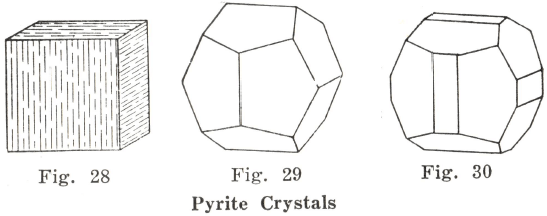
Pyrite is found in rocks of all ages. It burns freely when fed into special furnaces. The gas that is formed by the combustion is sulphur dioxide, SO2; it is used in the manufacture of sulphuric acid, and in the sulphite-pulp process. The furnace residue, called blue billy, is of the same composition as hematite, and it commonly used as an iron ore. Pyrite flotation concentrate is being used in a plant near Hamilton, Ontario, to produce elemental sulphur, sulphuric acid, and high grade iron ore. As a source of sulphur, native sulphur that is guaranteed 99.5% pure, at $25 to $30 per ton at the point of production, may compete favorably with pyrite, due to lower cost of transportation and of handling in the furnaces; but at prices above $30 for sulphur, pyrite might have the preference.
Marcasite
FeS2 — Marcasite has the same composition as pyrite, but is paler in color; whence. it is called white iron pyrites. It weathers more easily than pyrite, and is therefore more apt to have a sour, inky taste; H = 6 to 6.5; G = 4.85 to 4.90. It crystallizes in a different system, the orthorhombic (see Fig. 30A.) The crystals are wedge-shaped and are often in masses notched like the comb of a cock, whence the name cock’s comb pyrites.
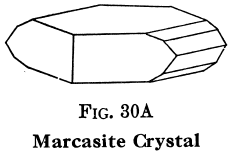
Copper Pyrites or Chalcopyrite
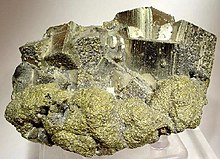 CuFeS2. Color, brass-yellow, rather deeper than pyrite, often tarnished with a variety of colors; powder greenish black; luster, metallic; H = 3.5 to 4; G = 4.1 to 4.3; it is much softer than pyrite, and is easily scratched with a knife; visible crystals (tetragonal system) are not common; cleavage, usually indistinct. Note that it is lighter than pyrite, a cubic foot weighing about 62.4 x 4.2 = 262 pounds, and there are nearly 8 cubic feet to the ton (2,000 ÷ 262 = 7.63). Taking the atomic weight of copper as 64, there are 64 parts of copper, 56 parts of iron, and 2 x 32 = 64 parts of sulphur, a total of 184 parts; hence, the proportion of copper is 64/184 = .348 = 34.8%, which is also the proportion of sulphur. The proportion of iron is 100 — (34.8 + 34.8) = 30.4%. Roughly, the ore may be considered as composed of one-third each of copper, sulphur, and iron. This is the commonest ore of copper; but its value depends so much on circumstances other than the percentage of copper contained in it that it is not quoted on the market.
CuFeS2. Color, brass-yellow, rather deeper than pyrite, often tarnished with a variety of colors; powder greenish black; luster, metallic; H = 3.5 to 4; G = 4.1 to 4.3; it is much softer than pyrite, and is easily scratched with a knife; visible crystals (tetragonal system) are not common; cleavage, usually indistinct. Note that it is lighter than pyrite, a cubic foot weighing about 62.4 x 4.2 = 262 pounds, and there are nearly 8 cubic feet to the ton (2,000 ÷ 262 = 7.63). Taking the atomic weight of copper as 64, there are 64 parts of copper, 56 parts of iron, and 2 x 32 = 64 parts of sulphur, a total of 184 parts; hence, the proportion of copper is 64/184 = .348 = 34.8%, which is also the proportion of sulphur. The proportion of iron is 100 — (34.8 + 34.8) = 30.4%. Roughly, the ore may be considered as composed of one-third each of copper, sulphur, and iron. This is the commonest ore of copper; but its value depends so much on circumstances other than the percentage of copper contained in it that it is not quoted on the market.
Copper pyrites is found in veins and lenses in a great variety of rocks, often mixed with iron pyrites, zinc blende, galena, pyrrhotite, bornite, and chalcocite. The important porphyry copper deposits will be discussed in Part 3.
Pyrrhotite or Magnetic Pyrites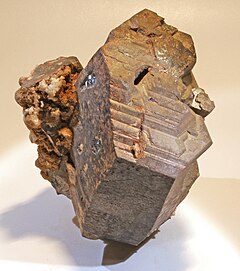
Color, bronze-yellow, sometimes inclined to copper-red, occasionally nearly gray; powder, grayish black; luster, metallic; H = 3.5 to 4.5; G = 4.58 to 4.64; magnetic; composition, iron and sulphur in variable proportions—iron 59% to 62%, and sulphur 41% to 38%. By reason of the lower sulphur content, pyrrhotite does not burn by itself, but requires that it be mixed with wood or coal. It cannot be used in place of iron pyrites, although it has been mixed with that mineral as a source of sulphur. Sometimes, as in the Sudbury district, it carries nickel; but most of the nickel is in the form of distinct minerals, especially pentlandite a sulphide of iron and nickel that contains 22% of nickel.
Pyrrhotite is found in many kinds or rocks; but, in large masses, it is usually associated with basic rocks, such as gabbro and norite.
Bornite or Peacock Copper Ore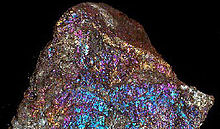
Color, copper-red or brownish, usually tarnished with a variety of colors, often very brilliant; powder, grayish black; luster, metallic; H = 3; G = 4.9 to 5.4; composition, copper, iron and sulphur in variable proportions, with copper from 44% to 71%; cleavage, almost absent. Bornite is found mostly with other copper ores.
Chalcocite or Copper Glance
Cu2S. — Color, dull, blackish lead-gray, often tarnished blue or green; powder, dark gray; luster, metallic; somewhat sectile, i. e., cuts with a smooth surface; H = 2.5 to 3; G = 5.5 to 5.8; cleavage, indistinct; composition, nearly 80% copper, with sometimes a little iron, and occasionally silver. Found mostly with copper pyrites and other copper ores, but occasionally alone, as in the sandstone near Dorchester, New Brunswick.
Tetrahedrite or Gray Copper Ore
Galena
 PbS. — Color, pure lead-gray: very fine-grained galena, (steel galena) is sometimes quite dark; powder, same as ore; may be weathered to white or gray; luster, metallic; H = 2.5 to 2.75; G = 7.4 to 7,6. Contains 86.6% lead, more or less silver, up to 1% or more, sometimes as a part of the galena, but sometimes as another mineral (as argentite) mixed with the galena. The opinion that paying quantities of silver are found oftener in fine-grained than in coarse-grained galena is not well founded. When galena carries about 25 ounces of silver to the ton, it begins to count as a silver ore; and when rich in silver, it is called silver lead. Crystals are in the cubic system, mostly cubes, sometimes octahedrons; cleavage (cubic), very perfect. The square corners and edges, both of the whole crystals and of the broken pieces, are very characteristic. This is the common ore of lead. Zinc blende is often found mixed with galena. From the mixed minerals, both lead and zinc can be extracted; but galena free from zinc blende is more easily worked.
PbS. — Color, pure lead-gray: very fine-grained galena, (steel galena) is sometimes quite dark; powder, same as ore; may be weathered to white or gray; luster, metallic; H = 2.5 to 2.75; G = 7.4 to 7,6. Contains 86.6% lead, more or less silver, up to 1% or more, sometimes as a part of the galena, but sometimes as another mineral (as argentite) mixed with the galena. The opinion that paying quantities of silver are found oftener in fine-grained than in coarse-grained galena is not well founded. When galena carries about 25 ounces of silver to the ton, it begins to count as a silver ore; and when rich in silver, it is called silver lead. Crystals are in the cubic system, mostly cubes, sometimes octahedrons; cleavage (cubic), very perfect. The square corners and edges, both of the whole crystals and of the broken pieces, are very characteristic. This is the common ore of lead. Zinc blende is often found mixed with galena. From the mixed minerals, both lead and zinc can be extracted; but galena free from zinc blende is more easily worked.
Galena is found in sedimentary rocks, particularly limestone, in crystalline limestone, slate, gneiss, etc.
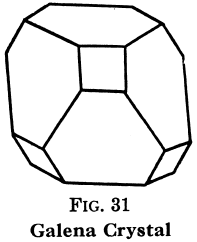
Jamesonite
Bournonite
Stibnite, Gray Antimony or Antimony Glance
Bismuthinite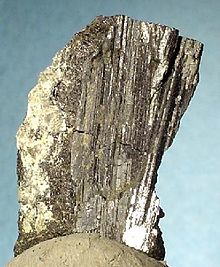
Bi2S3. — Color, lead-gray, to tin-white, may have yellowish or varied tarnish; powder, gray; luster, metallic; H = 2; G = 6.4 to 6.5; cleavage, good; melts very easily. Bismuthinite is an ore of the metal bismuth, but is found mostly in complex mixtures of ores of silver, cobalt, gold, etc., and the bismuth is extracted as a by-product, which sells at about $2.00 a pound. It is used in making easily fusible alloys (safety plugs), and in a number of medical and chemical substances.
Molybdenite
MoS2. — Color, pure lead-gray; powder, bluish gray or greenish gray; marks paper; luster, metallic; H = 1 to 1.5; G = 4.7 to 4.8; crystals, hexagonal; cleavage, very perfect, splits in thin layers, flexible, but not elastic. Molybdenite resembles graphite, but is decidedly bluish-gray; it is also much heavier than graphite. 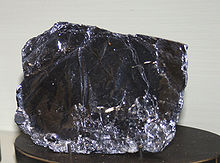 When the marks on paper are rubbed until spread out thin, that of graphite is gray, but that of molybdenite is greenish gray. It is an ore of the metal molybdenum, of which it contains 60%. It is used in making molybdenum steel and other alloys, and there are smaller uses in chemical analysis, etc. Value, 60 cents a pound of molybdenite in concentrates containing 90% of the mineral, equivalent to $108 per ton of such concentrates. It is found mostly in granite and gneiss, also in crystalline limestone; sometimes in gold veins.
When the marks on paper are rubbed until spread out thin, that of graphite is gray, but that of molybdenite is greenish gray. It is an ore of the metal molybdenum, of which it contains 60%. It is used in making molybdenum steel and other alloys, and there are smaller uses in chemical analysis, etc. Value, 60 cents a pound of molybdenite in concentrates containing 90% of the mineral, equivalent to $108 per ton of such concentrates. It is found mostly in granite and gneiss, also in crystalline limestone; sometimes in gold veins.
Argentite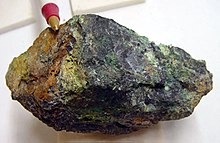
Ag2S.— Color, blackish lead gray; cuts like lead; when rubbed with knife, becomes shiny; luster, metallic; H=2 to 2.5; G = 7.20 to 7.36. Contains about 87% silver. Found with other ores in veins, mostly of calcite, in slate, graywacke, conglomerate, schists, and diabase.
Pyrargyrite or Dark-Red Silver Ore
Proustite or Light-Red Silver Ore
Cinnabar HgS
Color, cochineal-red, brownish red; sometimes grayish; powder, scarlet; somewhat sectile; luster, adamantine, sometimes near-metallic; H=2 to 2.5; G = 8. Cinnabar looks like red hematite and cuprite; is often found mixed with clay, hematite, etc. Found in veins in shale and slate, rarely in granite and porphyry.
Tellurides
These are compounds of tellurium with metals, found sometimes in gold ores. Tellurides of gold and silver are an important part of such ores. Tellurides have a metallic luster.

Sylvanite
(Au, Ag) Te2. — Sylvanite is a telluride of gold and silver in varying proportions; color, steel-gray to silver- white, inclining to yellow; H = 1.5 to 2; G = 7.9 to 8.3; good cleavage.
Calaverite
Calaverite is similar in composition to sylvanite; color, pale bronze-yellow.
Petzite
Petzite is also a telluride of gold and silver; color, steel-gray to iron-black. H=2.5 to 3; G=8.7 to 9.
Hessite
Hessite Ag2Te, is a lead-gray to steel-gray in color; somewhat sectile; H=2.5 to 3; G =8.31 to 8.45.
Altaite
Altaite PbTe, is tin-white in color, with yellowish tinge, may have bronze-yellow tarnish.
Coloradoite
Coloradoite, HgTe, is iron-black in color.
Kalgoorlite
Kalgoorlite is a telluride of gold, silver, and mercury; color, black.
Tetradymite
Tetradymite, Bi2Te3, is a telluride of bismuth; color, pale steel-gray; H = 1.5 to 2; G =7.2 to 7.6; marks paper; cleavage, perfect; flexible in thin sheets. When roasted, the tellurides of gold often show globules of metallic gold.
Smaltite
Chloanthite
Mispickel or Arsenopyrite

Dyscrasite
Niccolite
Breithauptic
Zinc Blende or Sphalerite
ZnS. Color, yellow, brown, black, sometimes nearly colorless; the black color is usually due to iron sulphide; rarer colors are red, white, and green; pure zinc sulphide is white; powder, brownish, yellow, or white; the darker varieties, (black jack,) which are the commonest, give a brownish powder; luster, resinous, particularly in the light-colored varieties; black zinc blende is somewhat metallic in luster; H = 3.5 to 4; G = 3.9 to 4.1. Zinc blende crystallizes in the cubic system; cleavage, very perfect. This is the common ore of zinc, of which it contains 67% when pure; it may carry silver and gold. Often found mixed with galena; this reduces the value of the ore, as a zinc ore, owing to the expense of separating. Found in sedimentary rocks such as limestone, crystalline limestone, limey shale, chert, and quartzite; also in veins in igneous rocks.
